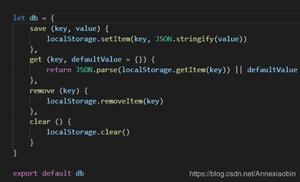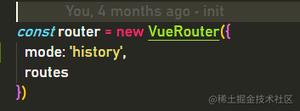react router @4 和 vue路由 详解(八)vue路由守卫

完整版:https://www.cnblogs.com/yangyangxxb/p/10066650.html
13、vue路由守卫
a、beforeEach
全局守卫
(每个路由调用前都会触发,根据from和to来判断是哪个路由触发)
const router = new VueRouter({ ... })router.beforeEach((to, from, next) => {
// ...
})
//每个守卫功能都有三个参数:
//to: Route:导航到的目标Route对象
//from: Route:当前路线被导航离开
//next: Function:必须调用此函数来解析钩子
// next():继续前进到管道中的下一个钩子。如果没有留下挂钩,则确认导航。
// next(false):中止当前导航。如果浏览器URL已更改(由用户手动或通过后退按钮),则会将其重置为from路径的URL 。
// next('/')或next({ path: '/' }):重定向到其他位置。当前导航将中止,并将启动一个新导航。你可以通过任何位置对象next,它允许您指定类似的选项replace: true,name: 'home'在使用任何选项router-link的to道具或router.push
// next(error):(2.4.0+)如果传递给的参数next是一个实例Error,导航将被中止,错误将传递给通过注册的回调router.onError()。
`
举个????
import Vue from 'vue';import Router from 'vue-router';
import LoginPage from '@/pages/login';
import HomePage from '@/pages/home';
import GoodsListPage from '@/pages/good-list';
import GoodsDetailPage from '@/pages/good-detail';
import CartPage from '@/pages/cart';
import ProfilePage from '@/pages/profile';
Vue.use(Router)
const router = new Router({
routes: [
{
path: '/', // 默认进入路由
redirect: '/home' //重定向
},
{
path: '/login',
name: 'login',
component: LoginPage
},
{
path: '/home',
name: 'home',
component: HomePage
},
{
path: '/good-list',
name: 'good-list',
component: GoodsListPage
},
{
path: '/good-detail',
name: 'good-detail',
component: GoodsDetailPage
},
{
path: '/cart',
name: 'cart',
component: CartPage
},
{
path: '/profile',
name: 'profile',
component: ProfilePage
},
{
path: '**', // 错误路由
redirect: '/home' //重定向
},
]
});
// 全局路由守卫
router.beforeEach((to, from, next) => {
console.log('navigation-guards');
// to: Route: 即将要进入的目标 路由对象
// from: Route: 当前导航正要离开的路由
// next: Function: 一定要调用该方法来 resolve 这个钩子。执行效果依赖 next 方法的调用参数。
const nextRoute = ['home', 'good-list', 'good-detail', 'cart', 'profile'];
let isLogin = global.isLogin; // 是否登录
// 未登录状态;当路由到nextRoute指定页时,跳转至login
if (nextRoute.indexOf(to.name) >= 0) {
if (!isLogin) {
console.log('what fuck');
router.push({ name: 'login' })
}
}
// 已登录状态;当路由到login时,跳转至home
if (to.name === 'login') {
if (isLogin) {
router.push({ name: 'home' });
}
}
next();
});
export default router;
b、beforeResolve(2.5.0新增)
全局解析守卫
和router.beforeEach类似,区别是在导航被确认之前,同时在所有组件内守卫和异步路由组件被解析之后,解析守卫就被调用 c、afterEach
全局后置钩子
router.afterEach((to, from) => { // ...
})
//不会接受next函数也
//也不会改变导航本身
d、beforeEnter
路由独享的守卫
const router = new VueRouter({ routes: [
{
path: '/foo',
component: Foo,
beforeEnter: (to, from, next) => {
// ...
}
}
]
})
//与全局前置守卫的方法参数是一样的
e、
组件内的守卫
beforeRouteEnterbeforeRouteUpdate(2.2新增)beforeRouteLeave
const Foo = { template: `...`,
beforeRouteEnter (to, from, next) {
// 在渲染该组件的对应路由被 confirm 前调用
// 不!能!获取组件实例 `this`
// 因为当守卫执行前,组件实例还没被创建
},
beforeRouteUpdate (to, from, next) {
// 在当前路由改变,但是该组件被复用时调用
// 举例来说,对于一个带有动态参数的路径 /foo/:id,在 /foo/1 和 /foo/2 之间跳转的时候,
// 由于会渲染同样的 Foo 组件,因此组件实例会被复用。而这个钩子就会在这个情况下被调用。
// 可以访问组件实例 `this`
},
//离开守卫通常用来禁止用户在还未保存修改前突然离开。导航该可以通过next(false)来取消
beforeRouteLeave (to, from, next) {
// 导航离开该组件的对应路由时调用
// 可以访问组件实例 `this`
}
}
//beforeRouteEnter守卫不能访问this,//因为守卫在导航确认前被调用,因此即将登场的新组件还没被创建。
//不过,可以你传通过一个回调给next来访问组件实例。
//在导航被确认的时候执行回调,并且把组件实例作为回调方法的参数。
beforeRouteEnter (to, from, next) {
next(vm => {
// 通过 `vm` 访问组件实例
})
}
完整的导航解析流程
- 导航被触发。
- 在失活的组件里调用离开守卫。
- 全局调用的
beforeEach守卫。 - 在重用的组件里调用
beforeRouteUpdate守卫(2.2+)。 - 在路由配置里调用
beforeEnter。 - 解析异步路由组件。
- 在被激活的组件里调用
beforeRouteEnter。 - 调用全局的
beforeResolve守卫(2.5+)。 - 导航被确认。
- 全局调用的
afterEach钩子。 - 触发DOM更新。
- 创建³³用实例好的调用
beforeRouteEnter守卫中传给next的回调函数。
以上是 react router @4 和 vue路由 详解(八)vue路由守卫 的全部内容, 来源链接: utcz.com/z/382866.html









